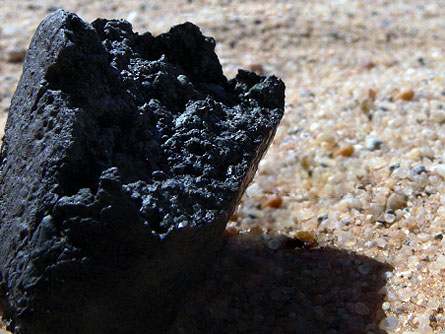The Earth-bound asteroid scientists saw coming
History-making asteroid tracked from space to its fiery demise in an African desert
Share this:
- Share via email (Opens in new window) Email
- Click to share on Facebook (Opens in new window) Facebook
- Click to share on X (Opens in new window) X
- Click to share on Pinterest (Opens in new window) Pinterest
- Click to share on Reddit (Opens in new window) Reddit
- Share to Google Classroom (Opens in new window) Google Classroom
- Click to print (Opens in new window) Print
 |
|
A meteorite from an asteroid tracked by scientists lies in the Nubian Desert in northern Sudan. The deep black color tells researchers that the rock is rich in carbon.
|
| Nature |
On October 7, 2008, an asteroid the size of a car blazed through the atmosphere. It eventually crashed into the Nubian Desert in the African nation of Sudan. Eyewitnesses who were looking up at the sky reported seeing a fireball over the desert. Then, this asteroid, named 2008 TC3, exploded.
Some people weren’t surprised by all the fireworks, though. For the first time in history, scientists were able to watch the asteroid as it flew through space, then entered Earth’s atmosphere and crashed into the desert. 2008 TC3 is the first asteroid to be observed both in space and on Earth. Before this asteroid’s arrival, scientists have had to rely on data from one place or the other.
Asteroids the size of 2008 TC3 are not uncommon. Fragments from one usually strike Earth every year. Because they are so small, Earth-bound asteroids usually remain unseen until they enter our atmosphere. Larger asteroids are easier to see, but are more rare.
“It’s like when bugs splatter on the windshield. You don’t see the bug until it’s too late,” says Mark Boslough. “You’d see a baseball coming towards the windshield much sooner.” Boslough is a physicist at Sandia National Laboratories in Albuquerque, N.M. And he studied the asteroid’s collision.
The astronomers who first observed 2008 TC3 got lucky. They didn’t know they were going to see it. “It just so happened that the asteroid was coming from the direction that the telescope was pointed in,” says Peter Jenniskens. He’s an astronomer at the SETI Institute in Mountain View, Calif. The astronomers first saw the asteroid on October 6, through a telescope on a mountain near Tucson, Ariz.
As they watched 2008 TC3 move across the sky, the scientists studied its mineral composition. To do this, they observed how the asteroid reflected sunlight. They also used tracking equipment to correctly predict when the asteroid would impact Earth. Shortly after the collision, Jenniskens and a team of astronomers and students from Sudan headed out into the desert to look for meteorites, pieces of the asteroid that survived the fiery trip through the atmosphere and landed on Earth. The team brought back about 47 meteorites from 2008 TC3.
Once they were able to study the fragments in the laboratory, the scientists quickly realized that the 2008 TC3 meteorites were unlike anything they had seen or studied before. More research on the pieces gave the scientists new information about the characteristics of different kinds of meteorites.
In addition to helping scientists understand more about asteroids, 2008 TC3 may prove to be helpful to humankind in the future. If a larger and more dangerous asteroid ever comes crashing toward Earth, scientists might see it coming.
Power words: (Adapted from the Yahoo! Kids Dictionary)
Meteorite: A stony or metallic mass of matter that has fallen to Earth’s surface from outer space.
Asteroid: Any of numerous small celestial bodies that revolve around the sun.
Telescope: Any of various devices used to detect and observe distant objects.
Atmosphere: The gaseous mass surrounding a celestial body and retained by the celestial body’s gravitational field.






